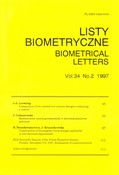
Listy Biometryczne - Biometrical Letters Vol. 34(1997), No. 2, 45-62


Consider nested row-column designs in which each square (termed a superblock) has 2 rows and 2 columns. Let an intersection of a row and column be a plot, and assume that only one treatment is allocated per plot. If two of the entries per superblock are filled with a control treatment (treatment 0), such that the control treatment occurs once per row and once per column, then there are a number of ways that the remaining plots may be filled. This paper examines two different designs which are non-binary, but which have the same eigenvectors as basic contrasts. The two designs are compared for fixed effect analysis, then for recovering information from the different strata. It is shown that when plot, row and column information are recovered and combined, the design providing lower variance on the control vs. treatment contrasts is dependent on the plot, row and column stratum variances.

nested row-column designs, canonical efficiency factors, controls, combining information

